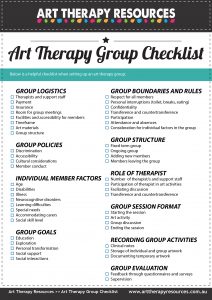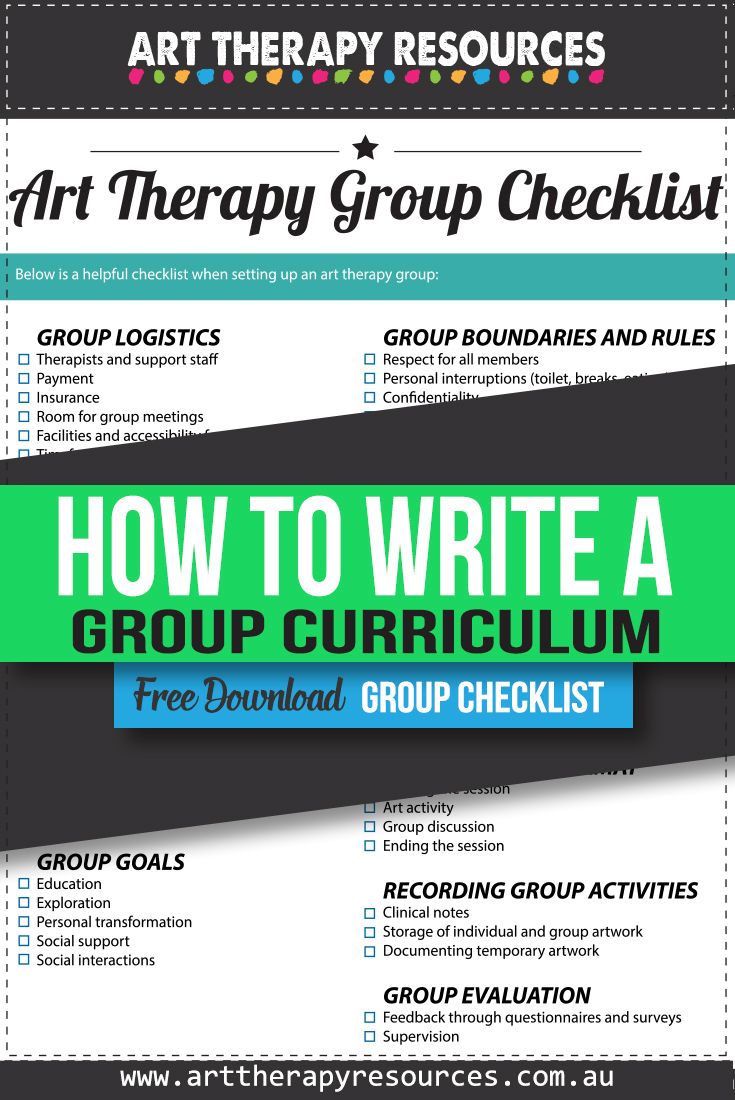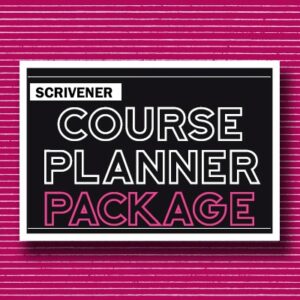THIS POST INCLUDES:
1. Benefits of Group Art Therapy
2. Benefits of Creating a Curriculum
3. Planning a Group Therapy Curriculum
4. Create Group Therapy Curriculum
5. Free Download Create A Curriculum Checklist
BENEFITS OF GROUP ART THERAPY
An art therapy group is an extension of individual therapy where it facilitates the therapeutic process by using art as a method of exploration of personal experiences and emotions.
A therapy group provides a different dynamic to individual therapy where a part of the healing process for the individual is derived through shared experiences with group members as well as group support.
An art therapy group can provide numerous benefits in place of individual therapy or group talk therapy.
Some common benefits of an art therapy group are listed below:
- encourages social learning through cooperation and communication
- support is provided by individuals with similar experiences
- exercises can be developed that utilize the number of people in a group (eg. role-playing)
- individuals can develop interpersonal skills within the group
- individuals can feel ‘safety in numbers’ while exploring their emotions
- individuals can experience sharing and providing support through the rules of engagement
- group work can develop a sense of community and reduce feelings of isolation
- group work can be less expensive than individual therapy
- group work develops an individuals exposure to diversity within a group of people
- the progress of other members can inspire and motivate members to make individual transformations
In addition to the benefits of an art therapy group, there are some factors to consider:
- establishing rules of confidentiality in the group
- groups require more resources
- an individual member may not get enough assistance
- group dynamics may create conflict between individual members
All of these issues can be addressed by establishing group rules and paying attention to how individuals and the group as a whole are functioning.
FURTHER READING:
For more information about conducting an art therapy group, check out our previous blog posts:
BENEFITS OF CREATING A CURRICULUM
Most art therapy sessions are run based on the needs of the individual client on that day. However, this can be difficult in a group setting where there are multiple individual needs. In this situation, it’s beneficial to establish a curriculum that you believe benefits the main purpose of the group.
For educational groups, a curriculum is essential in helping you ensure that your goals and purpose for the group are met. Having a curriculum in place helps you focus on your clients/students so that they understand the material in the group and can apply the learned material outside of the group setting.
PLANNING A GROUP THERAPY CURRICULUM
Your group therapy curriculum should focus on developing the following basic information:
- overall purpose and goal of the group
- group timeframe details
- learning methods involved – eg. Visual, audio, interactive etc
- group program content
- evaluation process to assess the success of the original group goals
- identify the resources required
CREATE GROUP THERAPY CURRICULUM
Once you have created your plan for your group therapy curriculum, you can begin the task of creating the content for your program.
It should be noted that this process will involve two main stages:
- Creating the curriculum
- Creating the content
The curriculum refers to the overall ideas and guidelines for the group program that you want to run. Creating the content refers to the actual information and activities that you will undertake in each group session.
You will need to record all of your ideas and your final group therapy curriculum. For this, process we recommend Evernote or Scrivener.
The below blog posts will help provide you with more insight into how to plan and be more productive in creating content like a group therapy curriculum:
- 10 Useful Tips to Use Evernote for Blogging
- Planning Template for Your Art Therapy Practice
- Review of Scrivener for Content Writing as a Therapist
Using the plan outline that you already created before you can start to develop the content of your curriculum.
OVERALL PURPOSE AND GOAL OF THE GROUP
In this section, you should identify who your group is designed to help. Some example ideas of groups include:
- Mothers with postpartum depression
- Men experiencing grief
- Elderly experiencing grief
- Teenagers affected by bullying
- General anxiety group
- Community groups affected by a local tragedy
Your group should be as defined as possible so that your content can be targeted to help the members with their specific problems. If you want to keep your group generalized then you can choose to run open art therapy groups which may serve the purpose of introducing the public to art therapy or art techniques in general.
As you define your group, attempt to answer the two fundamental questions of WHO and WHY. In the above examples, WHO describes: women, men, elderly, teenagers, community etc and WHY describes why the member is attending: PPD, grief, bullying, anxiety, trauma etc.
From this step you can now create your group curriculum name: Art Therapy Group for Teenagers Affected by Bullying
GROUP TIMEFRAME
Define the timeframe of your group and how and when it will be run. Examples include:
- 5 hour workshop broken into 1 hour learning blocks with 10 minute breaks between
- 1 hour morning group, no breaks required
- Weekend workshop with morning educational content and afternoon free time for art creating
- 12 week program with weekly 2 hour sessions
Knowing your timeframe will help provide the foundation on which you can build your group program content. If your timeframe is a longer period, you can use the time to build upon concepts each week, however, if your group program is a single session you will need to create succinct content.
LEARNING METHODS
As you define your program list out the learning methods that you will use in the group. Some learning methods may include:
- Video providing educational material on anxiety
- Audio meditations before the art therapy sessions begin
- Printed material to hand out for homework or assessment
GROUP PROGRAM CONTENT
From the above steps, you will have now created the foundation of your group program so that you can begin creating your content. Start with an outline that is suited to your timeframe. If you are running a single session, then your outline will be simple and may only involve a short introduction to the session, followed by some educational material and then time for creating art.
If you are running a group program over many weeks, then you will have more flexibility to introduce educational and interactive material. You will also have more opportunities to seek feedback from your students/clients about their interaction with the group process.
As you create your content it is important to stay focused on your goals. You should develop a simple framework of goals based on your timeframe so that your group members are not overwhelmed by a large content load.
As art therapy work can be emotionally demanding, it’s important to allow space and time for your group members to absorb, create, and reflect without strict time limits that may create pressure.
EVALUATION PROCESS
The idea of evaluation may sound formal however, it can help you determine if your group members are receiving benefits from the program that you have created.
Evaluations can be used in the group throughout the program so you receive timely feedback or it can be provided once the group program is completed.
If evaluations are done at the end of the program then you can only use the feedback to amend future group work. Alternatively, introducing smaller evaluations throughout the program may give you an opportunity to adjust your group program as you deliver it.
This evaluation process can cover both the program curriculum as well as the logistics of the group. For example, your group curriculum may be effectively working, however, your art room may be set up in a way that’s not conducive to group work.
The evaluation process can be as formal as requiring group members to complete paperwork or it can be as simple as asking the group if everyone is comfortable with the cooling/heating?
When you create your program content, identify the criteria in your group that you would like to evaluate. You can then determine if the items to evaluate can be done informally or formally and in what format suits the criteria.
IDENTIFY THE RESOURCES REQUIRED
Once your program content is created and the logistics of your group program is determined, you can begin to create a resource list of all the items you will need to run your group work effectively.
This can involve printed material, tea/coffee/water, art supplies, technology, room facilities, images, marketing materials and more.
This resource list will also help you determine the cost of running your art therapy group and any associated fees that you will charge.
Need help with creating your group art therapy curriculum?
If you need help to create your curriculum, we provide an Ecourse Planner Package in the store that will suit the development of curriculum content.
You can purchase the package in a variety of different formats including:
The course planner package provides a roadmap on how to get your course completed from choosing your course topic to creating course content and then launching your course with a strong marketing strategy in place.
If you’re ready to create your next course or workshop then this package is perfect for you.
Creating an online course, or in person workshop could be exactly what your therapy business needs to help bring more exposure to your business. Courses and workshops are also an excellent way to create alternative income for your art therapy business.
Maybe you’ve considered creating a course before but abandoned the idea because it seemed too much work for an uncertain outcome.
Creating a course can be daunting from designing your course structure, to creating your course content, and then finally putting into place the most effective marketing techniques to sell your course.
This course planner package provides a roadmap on how to get your course completed from the first step of coming up with your course topic, all the way through to creating course content and then finally launching your course.
The course planner package does not contain generalised information about courses but instead provides helpful detail on how to execute the necessary steps to get your course completed.
The package includes 4 major sections:
- Course Admin – the course admin section will help you to establish the administrative foundation that will help support your course creation process. Setting up the basic admin structure you need will help boost your productivity and efficiency in getting your course completed.
- Course Design – this section will help provide you with the core decisions that have to be made about your course topic, format and delivery method. Included is the essential components of creating your course modules.
- Marketing – once your course is completed, you will need to implement an effective strategy to market your course. This section contains specific details about the marketing assets you will need and the sales channels you should market.
- Worksheets – here’s where you get to work! These worksheets provide all you need to complete your course fast!
Using the resources in this package makes the process of creating your course so much easier.
This package will save hours of wasted time trying to understand what you need to organise, create and market your course for your therapy business.
If you’ve always wanted to create a course but struggled to find a place to start, this package will provide you with a clear direction to get your course completed.
The package is full of actionable worksheets to help get your course done!
After working through this package you will:
- Have a step by step project plan to create your next course
- Centralise all of your course assets for easy updating
- Select tech gear to create your course and 3rd party platforms to host your course
- Create an effective customer sales funnel to sell your course
- Construct your sales emails using our email outlines
- Decide on your course topic, form and method
- Create your course using the module template
- Create the necessary marketing assets you will need for your course
- Devise a blogging strategy to help market your course
- Use the 30 day planner to complete your course
The contents of this package include the following sections:
COURSE ADMIN
- Master Checklist
- Admin
- Tech
- Financial
- Folder Structure
- Planning
- Customer Sales Funnel
COURSE DESIGN
- Course Topic
- Course Format
- Course Delivery
- Course Creation
MARKETING
- Marketing Assets
- Blogging
- Social Media
- External
WORKSHEETS
- Worksheet List
- Master Checklist
- Important Links
- Financial
- Folder structure
- Sales funnel
- 30 Day Planner
Course modules
Sales page content
Email outlines
Below is a breakdown of the individual sections within each major category in this package.
COURSE ADMIN
Master Checklist
The master checklist contains the necessary steps to complete your course. It also includes an additional checklist of things to do for an in-person workshop.
Admin
It’s important to centralise the administration of your most important documents and files used to create your course including lead magnets, sales pages, your folder structure, software, payment system access, and policy documents.
Tech
Use our comprehensive list of tech gear including administration tools as well as content creation, course delivery and marketing tools and software.
Financial
Included in this Course Planner Package is an excel spreadsheet that you can use to calculate the number of courses you need to sell to break even. You can also use the spreadsheet to record your estimated profit and your actual profit once your course has been completed.
Folder Structure
Included in the Course Planner Package is a suggested folder structure to help keep your documents organised for quick access. We’ve also included a file naming template to help you improve your information management process.
Customer Sales Funnel
A sales funnel helps you craft your marketing message to your audience. Included in the Course Planner Package are 3 different sales funnels and the steps involved in marketing your course.
Planning
Included are the basic steps to plan your course workflow, including suggested programs to use to set up your course management system.
COURSE DESIGN
Course Topic
Included in this section are the questions you need to consider before finalising your course topic. Also included is a list of online sources to help consolidate your course topic ideas.
Course Format
You can choose to deliver your course using a variety of different formats. You can also mix and match different formats. Included is some suggestions on how to structure your course format.
Course Delivery
This package will help you decide on your course delivery method including suggestions on how to host your course online.
Course Creation
Use the provided checklist to create your course content. Use the module templates as a guide on what content to include in each module. Included is 2 examples of a module structure including single lesson and multiple lessons.
MARKETING
Marketing Assets
Throughout the marketing process, you will need to create many documents, files and images to create your marketing materials. Included is a list of the common items you will need to market your course. Also included is a sales page example layout and a checklist of key components that should appear on your sales page.
Blogging
Your website is a central hub to market your course and your blog is the key place to promote your course. Included are details about creating your necessary lead magnet along with a list of 20 Lead Magnets you can use for your course.
Social Media
In this package is a simplified list of the items you should be publishing on your social media platforms while launching your course. Included are important tips about creating a hashtag/tag list to help boost the visibility of your course.
Email
Included is 2 examples of how you can schedule your email content based on your course structure. Learn about the educational emails you should include in your email content, including some useful examples of specific educational emails you can write.
External
In the Course Planner Package you will find details about where to market your course externally.
WORKSHEETS
Worksheet List
This is a summary list of the worksheets available to use in your Course Planner Package.
Master Checklist
The master checklist contains the necessary steps to complete your course. It also includes an additional checklist of things to do for an in-person workshop.
Important Links
Use this template to record your important links used in your course including payment systems, course pages, social media, course management software, marketing links and more.
Financial
Use this Excel spreadsheet to calculate the number of courses you need to sell to breakeven. You can also use the spreadsheet to record your estimated profit and your actual profit once your course has been completed.
Folder Structure
Use the suggested folder structure to help keep your documents organised for quick access. Also included is a file naming template to help you improve your information management process.
Sales Funnel
Use the 3 different scenarios below to build your ideal sales funnel. You can use one of the examples below or use a combination. Your sales funnel should suit your course and your audience.
30 Day Planner
Use this 30 Day Planner to set weekly and daily to-do’s to get your course completed. Included is the 4 main goals you will need for each course you create.
Course Modules
Use the module templates as a guide on what content to include in each module, including your welcome module and final summary module.
Sales Page Content
Use the sales page layout graphic as a guide to create your sales page. Also included is a template to craft your headlines, details and benefits and overall sales page structure.
Email Outlines
Use these outlines as a guide to construct your email content for each step in your sales funnel. Includes 6 email outlines that are necessary for your course launch.
FREE DOWNLOAD: Art Therapy Group Checklist
SIGN UP below to download the FREE Art Therapy Group Checklist to help establish and run your Art Therapy Group.

BUILD YOUR ART THERAPY REFERENCE MATERIALS:
Pin this image to your Pinterest board.

SHARE KNOWLEDGE & PASS IT ON:
If you’ve enjoyed this post, please share it on Facebook, Twitter, Pinterest. Thank you!



